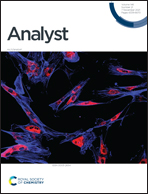Ligation-dependent rolling circle amplification method for ATP determination with high selectivity and sensitivity
Abstract
It is highly demanded to develop methods for the reliable detection of ATP, which plays an extremely important role in clinical diagnosis, biomedical engineering, and food chemistry. However, the methods currently available for ATP sensing strongly rely on the utilization of expensive and sophisticated instruments or the use of ATP aptamers with mediocre sensitivity and selectivity. To circumvent these drawbacks, we herein propose an efficient method for ATP detection by integrating highly specific ATP-dependent ligation reaction with dual-stage signal amplification techniques executed by rolling circle amplification (RCA) and the subsequently fabricated DNAzymes ready for the catalytic cleavage and fluorescence signal generation from molecular beacons (MBs). The detection limit is down to 35 pM with a linear range from 0.05 nM to 200 nM. More importantly, the sensing strategy can effectively discriminate ATP from its analogues and the results from the spiked human serum albumin (HSA) samples further confirm the reliability for practical applications. Considering the high sensitivity and selectivity, wash-free and isothermal convenience, and the simplicity in probe design, the strategy reported herein paves a new avenue for the effective determination of ATP and other biomolecules in fundamental and applied research.



 Please wait while we load your content...
Please wait while we load your content...